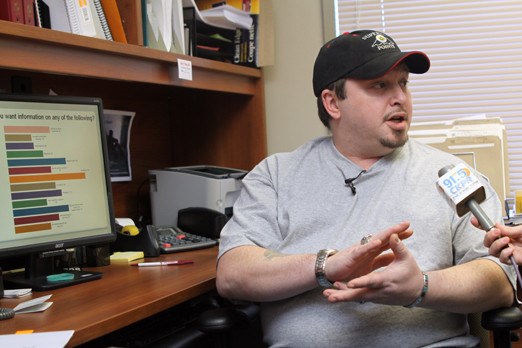The number of people using OxyContin in Thunder Bay has exploded and shows no signs of slowing down, says a local outreach worker.
Michael Croft, an injection drug use outreach worker for AIDS Thunder Bay, said with the exception of alcohol and marijuana, OxyContin is the most used drug in the city.
“It’s going to keep growing,” Croft said. “OxyContin use has exploded. We have a larger amount of people using than before and we have a larger amount of people using heavier narcotics than before.
“OxyContin is by far the no. 1 drug being used right now, it has surpassed everything else. Cocaine used to be really high, but it has surpassed that.”
OxyContin, or the generic OxyCodone, is an opiate used to treat pain and has become infamous for its habit-forming track record.
According to the study titled An Environmental Scan of Thunder Bay: Issues, Impacts, and Interconnections of Substance Abuse, OxyContin was celebrated following its creation in 1996 by American pharmaceutical company Purdue Pharma for being a less addictive than other pain relievers.
Former executives of the company later pleaded guilty to charges of misleading the public about the safety of the drug, which eventually led to a $634 million fine against the drug company.
The drug’s addictive properties have been evident in Thunder Bay recently where in less than two weeks city police have responded to three robbery attempts of pharmacies. A suspect used a syringe as a weapon at each of the incidents and demanded prescription drugs from the person working the pharmacy counter.
In all three cases the suspect’s demands included OxyContin. Two of the robberies resulted in suspects leaving the scene with an undisclosed amount of pills.
Croft said that despite the three robberies, it isn’t fair to say all addicts resort to crime.
“Within any group of people there are going to be a small percentage who will rob a pharmacy, or rob a store,” he said. “When people get desperate, they do desperate things. But it’s a small percentage. Not every drug addict is going out robbing a pharmacy or mugging someone.”
The desperation often follows the withdrawal symptoms OxyContin addicts face. Croft said those symptoms can be very severe and may include muscle soreness, bone aches, headaches, vomiting and diarrhea.
Aids Thunder Bay took a close look at drug use in the city through its 2010 study titled Engaging Populations at Risk. Lawrence Korhonem, executive director of AIDS Thunder Bay, said the study gave the organization the evidence it needed to conclude prescription pills are being used more in this community than substances like crack or cocaine.
AIDS Thunder Bay isn’t the only organization with numbers showing the growing use of OxyContin in the area.
The Thunder Bay District Health Unit has been able to get a look into the youth use of drugs through its Northwestern Ontario Drug Use Survey, which the organization conducts every four years.
That survey revealed that drug use among area students is equal to the provincial average. But the statistics aren’t the same for prescription drugs, which youths in this region are using at nearly double the rate of the provincial average – 3.1 per cent here against Ontario’s 1.6 per cent.
The health unit hasn’t been able to gather the same information for adults.
“For adults we don’t have that kind of tool available, “ said Patty Hajdu, drug strategy co-ordinator with the Thunder Bay District Health Unit.
“Even some of the more standardized tools that might be used on a provincial or federal level to assess people’s health behaviors in general aren’t that effective at getting illicit drug use because people aren’t always that open to talking about that in a telephone interview.”
Provincially, the health unit has statistics showing that Oxycodone use increased across Ontario by 850 per cent between 1991 and 2007.
Strategies to help change these kinds of statistics are starting to surface while others are en route. Hajdu said the College of Physicians and Surgeons of Ontario has recently released prescribing guidelines to help doctors assess whether or not a patient is suitable for opiate treatment.
Meanwhile, Ontario will be launching a prescription tracking system sometime in 2011 to help track the prescriptions of opiates like OxyContin.
But there’s no simple solution to fixing the issue of rising OxyContin dependency entirely, Croft said.
“Most people are using for the same reason, just trying to feel better about their ... lives. They don’t want to feel the way they're feeling,” Croft said. “There are so many things that have to change that you can’t pinpoint it to one or two little things.
“When people start feeling pride in what they are doing, they will turn themselves around. And people do turn themselves around all the time.”
Sign in or register
- Messages
- Post a Listing
- Your Listings
- Your Profile
- Your Subscriptions
- Your Likes
- Your Business
- Support Local News
- Payment History
Registered Users
Already have an account?
New Users
Create a free account.
